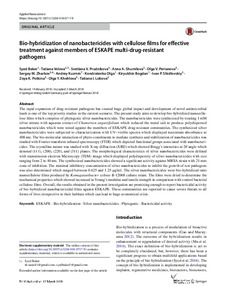Показать сокращенную информацию
Bio-hybridization of nanobactericides with cellulose films for effective treatment against members of ESKAPE multi-drug-resistant pathogens
| Автор | Syed, Baker | |
| Автор | Tatiana, Volova | |
| Автор | Svetlana V. Prudnikova | |
| Автор | Anna A. Shumilova | |
| Автор | Olga V. Perianova | |
| Автор | Sergey M. Zharkov | |
| Автор | Andrey, Kuzmin | |
| Автор | Kondratenka, Olga | |
| Автор | Kiryukhin, Bogdan | |
| Автор | Ivan P. Shidlovskiy | |
| Автор | Zoya K. Potkina | |
| Автор | Olga Y. Khohlova | |
| Автор | Tatiana I. Lobova | |
| Дата внесения | 2019-07-01T07:28:28Z | |
| Дата, когда ресурс стал доступен | 2019-07-01T07:28:28Z | |
| Дата публикации | 2018-06 | |
| Библиографическое описание | Syed, Baker. Bio-hybridization of nanobactericides with cellulose films for effective treatment against members of ESKAPE multi-drug-resistant pathogens [Текст] / Baker Syed, Volova Tatiana, Svetlana V. Prudnikova, Anna A. Shumilova, Olga V. Perianova, Sergey M. Zharkov, Kuzmin Andrey, Olga Kondratenka, Bogdan Kiryukhin, Ivan P. Shidlovskiy, Zoya K. Potkina, Olga Y. Khohlova, Tatiana I. Lobova // Springer Biomaterials: Applied Nanoscaence. — 2018. — Т. 8 (№ 5). — С. 1101-1110 | |
| URI (для ссылок/цитирований) | https://link.springer.com/article/10.1007/s13204-018-0717-9 | |
| URI (для ссылок/цитирований) | https://elib.sfu-kras.ru/handle/2311/111165 | |
| Описание | Текст статьи не публикуется в открытом доступе в соответствии с политикой журнала. | |
| Аннотация | The rapid expansion of drug-resistant pathogens has created huge global impact and development of novel antimicrobial leads is one of the top priority studies in the current scenario. The present study aims to develop bio-hybridized nanocellulose flms which comprise of phytogenic silver nanobactericides. The nanobactericides were synthesized by treating 1 mM silver nitrate with aqueous extract of Chamerion angustifolium which reduced the metal salt to produce polydispersed nanobactericides which were tested against the members of ESKAPE drug-resistant communities. The synthesized silver nanobactericides were subjected to characterization with UV–visible spectra which displayed maximum absorbance at 408 nm. The bio-molecular interaction of phyto-constituents to mediate synthesis and stabilization of nanobactericides was studied with Fourier-transform infrared spectroscopy (FTIR) which depicted functional groups associated with nanobactericides. The crystalline nature was studied with X-ray difraction (XRD) which showed Bragg’s intensities at 2θ angle which denoted (111), (200), (220), and (311) planes. The morphological characteristics of silver nanobactericides were defned with transmission electron Microscopy (TEM) image which displayed polydispersity of silver nanobactericides with size ranging from 2 to 40 nm. The synthesized nanobactericides showed a signifcant activity against MRSA strain with 21 mm zone of inhibition. The minimal inhibitory concentration of silver nanobactericides to inhibit the growth of test pathogens was also determined which ranged between 0.625 and 1.25 μg/ml. The silver nanobactericides were bio-hybridized onto nanocellulose flms produced by Komagataeibacter xylinus B-12068 culture strain. The flms were dried to determine the mechanical properties which showed increased in Young’s modulus and tensile strength in comparison with control bacterial cellulose flms. Overall, the results obtained in the present investigation are promising enough to report bactericidal activity of bio-hybridized nanobactericidal flms against ESKAPE. These communities are reported to cause severe threats to all forms of lives irrespective to their habitats which can lead to huge economical crisis. | |
| Тема | Bio-hybridization · Silver nanobactericides · Phytogenic · Bactericidal activity | |
| Название | Bio-hybridization of nanobactericides with cellulose films for effective treatment against members of ESKAPE multi-drug-resistant pathogens | |
| Тип | Journal Article | |
| Тип | Journal Article Postprint | |
| Страницы | 1101-1110 | |
| ГРНТИ | 34.45 | |
| Дата обновления | 2019-07-01T07:28:28Z | |
| DOI | 10.1007/s13204-018-0717-9 | |
| Институт | Институт нефти и газа | |
| Подразделение | Базовая кафедра химии и технологии природных энергоносителей и углеродных материалов | |
| Журнал | Springer Biomaterials | |
| Квартиль журнала в Web of Science | Q2 |

